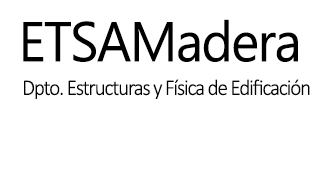Title (acronym): Construction system for strained gridshells based on new high-performance timber products and digital fabrication (GRIDADIGTION)
Reference: PID2020-112954RA-I00
Funding: State R&D Program Oriented to the Challenges of the Society, in the framework of the National Plan for Scientific and Technical Research and Innovation, Spanish Ministry of Science and Innovation.
Duration: 4 years (01/09/2021 – 31/08/2025)
Budget: 107.327,00 €
Financed amount: 88.700,00 €
Principal Researcher: Dr. Almudena Majano Majano
Team
Technical University of Madrid:
- Dr. Almudena Majano Majano
- Dr. Antonio José Lara Bocanegra
- Antonio Roig Vena
- José Luis Gómez Royuela
- Laura Gonzalo Calderón
- Dr. José Ramón Aira Zunzunegui
- Carlos Martínez Criado
- José María Herranz
University of the Basque Country:
- Dr. Francisco González Quintial
University of Seville:
- Dr. Andrés Martín Pastor
University of Extremadura:
- Dr. Pablo Vidal López
- Dr. José Ramón Villar García
- Dr. Desirée Rodríguez Robles
University of Santiago de Compostela:
- Dr. Juan Ortiz Sanz
NOVA University Lisbon:
- Dr. José Manuel Cardoso Xavier
Edinburgh Napier University:
- Dr. Bernardino D’Amico
The University of Edinburgh:
- Dr. Thomas Reynolds
Abstract
The environmental advantages that timber construction offers, together with the growing development of new technological products and the possibilities provided by CNC technologies, are allowing realizations with wood that were unimaginable until a few years ago, such as tall buildings or gridshell structures of complex geometries.
Timber gridshells are highly efficient and aesthetically attractive structures, suitable for lightweight roofs of medium and large spans, which acquire their bearing capacity and stiffness mainly due to their shape. The efficiency, expressive capacity and the ever-increasing demands for low-carbon construction make these structures of increasing interest to architects and engineers.
However, despite the interest, this type of structures has not become popular today for use in common applications such as covering sports centers, schools or industrial or rural buildings. This is due to some difficulties that prevent the development of an economic construction technique for gridshells, so their use is generally relegated to singular works.
The objective of the present project is to develop a new construction system for timber gridshells that minimizes the cost of material, labour and auxiliary resources and that is competitive for application in standard works. For this, it is proposed to integrate the active bending in the forming process with the use of wood-wood joints made by CNC.
Currently, the application of the active bending in the forming process is only economically feasible if a material with high mechanical performance is available, which allows fast and dry bending while maintaining a high structural reserve. This is not possible with the timber products commonly used in the construction of this type of structure, whose moderate strength made it necessary to bend the material wet and at a very slow speed to allow adequate dissipation of bending stresses.
To overcome this difficulty, it is proposed to develop a high-performance laminated veneer lumber (LVL) made of a national species, Eucalyptus globulus. It will be a product with board format that make possible CNC machining of all the laths and joints at the same time, and will show a very high bending strength (at least 80MPa of characteristic strength is expected). For this purpose, the mechanical properties will be experimentally characterized for different stresses, orthotropy directions and veneer distribution configurations.
Likewise, a new multilayer connection system will be developed, solved by means of wood-wood joints made by CNC that will make possible a simple, precise and fast bending and installation process. Prototypes will be built and analysed experimentally and numerically. The results will allow the development of a global analysis model for gridshells built with this system.
Finally, the construction of a full-scale demonstrator will make it possible to put the proposed construction system into practice and validate, through a load test, the developed structural analysis model.
Related publications
-
Majano-Majanoa A, Lara-Bocanegra AJ, Pereira F,Xavier J, Morais J, de Moura MFSF (2023) Direct and inverse cohesive law identification of hardwood bonded joints with 1C-PUR adhesive using DCB test. Composite Structures (2023) 117013
-
Roig A, Lara-Bocanegra AJ, Xavier J, Majano-Majano A (2022) Design Framework for Selection of Grid Topology and Rectangular Cross-Section Size of Elastic Timber Gridshells Using Genetic Optimisation. Applied Sciences 13(1):63.
-
Gómez-Royuela JL, Majano-Majano A, Lara-Bocanegra AJ, Xavier J, De Moura M (2022) Shear traction‐separation laws of European beech under mode II loading by 3D digital image correlation. Wood Science and Technology 56(6)
-
Lara-Bocanegra AJ, Majano-Majano A, Ortiz J, Guaita M. (2022) Structural Analysis and Form-Finding of Triaxial Elastic Timber Gridshells Considering Interlayer Slips: Numerical Modelling and Full-Scale Test. Applied Sciences 12, 5335





